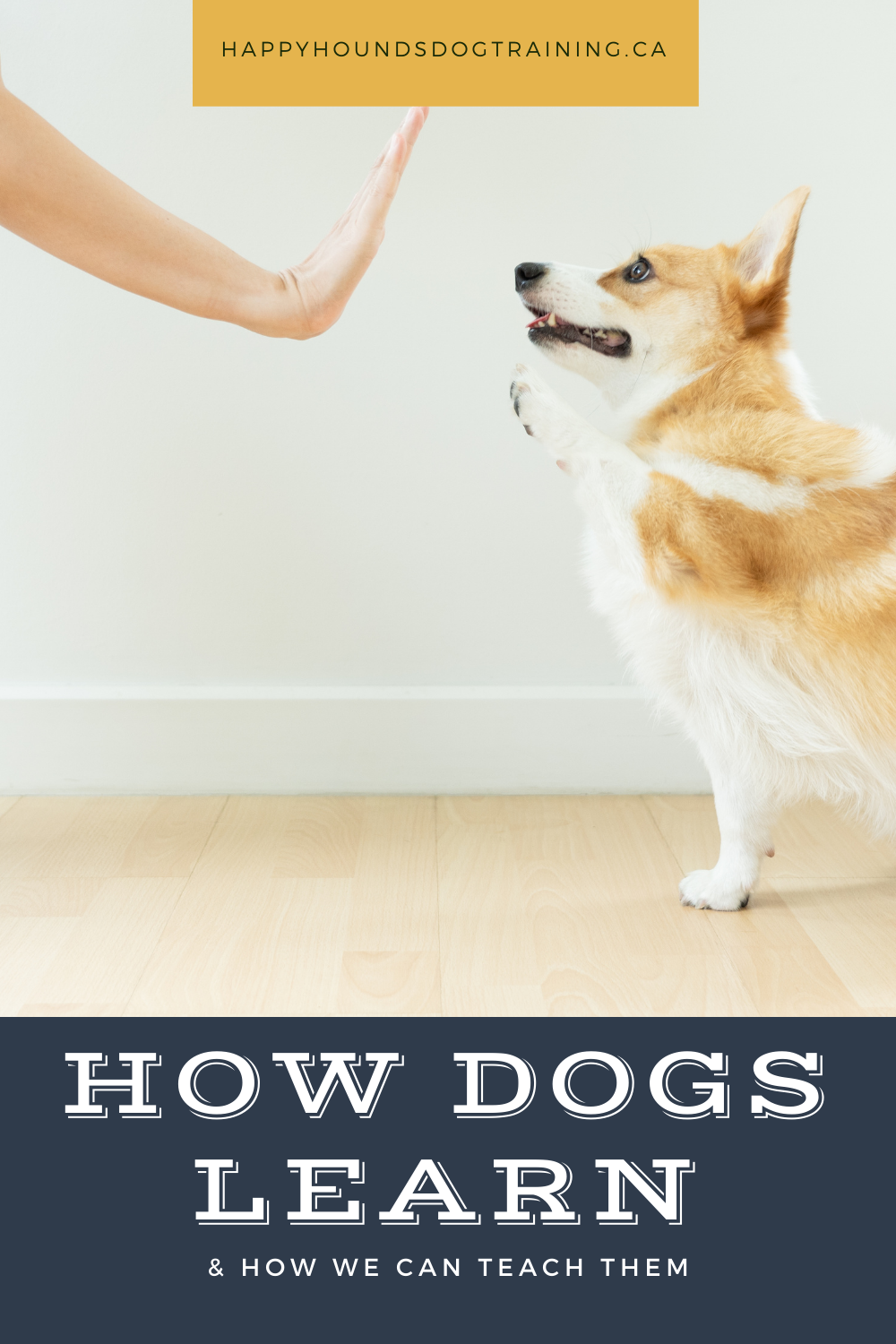How Dogs Learn
Dogs have evolved with humans for thousands of years. They have learned ways of bonding with us, how to sense our emotions, and they can understand basic hand gestures and words. Maybe it’s time we reciprocated and learned more about them? When you understand how dogs learn it can help you to teach them the things you’d like them to know and discourage the behaviors you dislike. This will lead a better relationship between dog and owner, which is always my goal.
In this article we will cover:
- How dogs learn
- What is classical conditioning?
- What is operant conditioning?
- How humans can accidentally teach our dogs things we didn’t mean to
How do dogs learn?
Whether we want them to be or not, dogs are ALWAYS learning. Problems arise when the owner thinks they’re teaching one thing, but the dog is actually learning the opposite.
Picture this:
You walk in your front door after work. Immediately you brace for impact. Your excited Rottweiler Zeus has rounded the corner so excited to see you that he’s about to tackle you better than a pro football star could.
“Zeus!” you loudly squeal as he jumps up and drowns you in a slobber shower. You push him off a few times while trying to maintain your balance.
“Why does this keeps happening?” you wonder. You think you’re correcting Zeus every time he jumps on you, so why is it getting worse? (Hint: you’re accidentally reinforcing it. More on that at the end of the post).
Unfortunately, most humans do not understand how dogs learn so they often reinforce the very behavior they’re trying to fix.
So how do dogs learn? There are two different conditioning methods.
- Classical conditioning
- Operant conditioning
Both styles occur naturally and are always at work. As the owner it is our responsibility to apply them in ways that show our dogs what we want them to learn.

What is classical conditioning?
Classical conditioning is learning by association.
The most famous example of classical conditioning is Pavlov’s dogs. Pavlov was conducting experiments on dog salivation, and accidentally discovered classical conditioning. He would ring a bell every day before feeding the dogs. Eventually, the dogs would salivate just as much at the sound of the bell as they would at the sight of the food.
There are some things that dogs do not need to “learn”. For example, dogs naturally salivate at the sight of food. Anyone who has seen a bulldog watching their owners eat dinner knows exactly what I’m talking about. The drool is intense.
However, a bell does not naturally mean anything to a dog. It’s neutral.
Classical conditioning occurs when a dog associates a natural stimulus with the one that used to be neutral. In Pavlov’s example, by ringing the bell right before giving food the dog associated food with a bell sound. Eventually, the dog would have the same physical response to a bell (without food visible) as it would to the food itself. Now bell = drooling.
A more common example of classical conditioning is a dogs response to seeing their leash.
Dogs naturally love getting outside for a walk. That does not need to be trained.
However, a leash initially means nothing to them. It’s a neutral object.
Eventually through classical conditioning the dog learns that leash = walk and gets excited when it sees the leash picked up. The dog has associated the leash with walks and now has the same response to both.
Classical conditioning (good & bad) happens all the time, often without our knowledge.
When applied intentionally, classical conditioning can be an incredibly powerful method of re-wiring a dogs emotional response to a stimulus. This can help with aggression, barking, and fear when used properly.

However, classical conditioning can also accidentally cause associations you didn’t intend to.
An example of this that trainers often see is shock collars causing increased aggression.
Many people these days use shock collars to teach their dog recall (read my argument against this aversive training). A common place you see shock collars is at a dog park because it’s often a place where the dogs recall wasn’t trained properly enough to be effective.
The owner calls the dog but the dog is too distracted/insufficiently trained to listen, so the owner shocks the dog.
The dog does not understand where the pain came from, so they might wonder if it was caused by the dog close by.
With enough repetitions, that dog can learn that being close to another dog= pain, and they become reactive when another dog comes close.
The owner has no idea that the shock collar and classical conditioning programmed their dog to be aggressive. It wasn’t the dogs fault at all! The owner just didn’t understand how dogs learn.
What is operant conditioning?
Operant conditioning sounds intimidating, but it simply means learning by consequence.
“Consequence” can either be a good (treats, praise, toys) or a bad thing that happens to that dog. Dogs do things that work out well for them, and stop doing things that don’t.
The basic “rules” of how dogs learn from operant conditioning:
1- If a dogs behavior has an enjoyable consequence they will want to repeat it. An example is when you ask your dog to sit and then give him a treat when he does.
Dog: I put my butt on the ground and I got a tasty! I love tasties! I will put my butt on the ground more often!
2- If a dogs behavior has an unpleasant consequence it will happen less often. An example would be jerking on your dogs collar when they walk in front of you rather than heeling.
Dog: When I walked in front my neck hurt. I don’t like my neck hurting. I won’t walk in front next time.
How dogs learn from the 4 quadrants of operant conditioning
The 4 quadrants of operant conditioning can get a little confusing due to our personal association with the particular words that are used.
The first important thing to know:
In operant conditioning, positive and negative do NOT mean good and bad. Think of it more like a math problem.
Positive is the addition of something (it could be giving a treat or adding a shock collar).
Negative is the removal of something (could be taking away a dogs toy or removing pressure from prong collar).
The other important thing to know:
Punishment is not necessarily bad! Punishment and aversives (such as shock collars, prong collars, hitting your dog) are NOT the same thing.
In operant conditioning punishment only refers to causing the dogs behavior to happen less frequently.
Reinforcement refers to causing that behavior to happen more frequently.
In can be slightly confusing to wrap your head around, but in a chart the 4 quadrants look like:

Applying it: Let’s say your goal is to teach your dog to walk nicely on leash.
In this case:
The reinforced behavior (what you want increased) is polite leash walking.
The punished behavior (what you want decreased) is pulling on the leash.
How could you achieve this using the 4 quadrants of operant conditioning?
1) Positive Reinforcement (R+)
ADD something good!
To get your dog to walk nicely you could add a treat (positive) to encourage them to stay by your side (reinforcing that polite leash walking will happen again).
2) Negative Punishment (P-)
REMOVE good stuff!
Your dog pulls on the leash trying to get to a smell. Instead of being pulled over there, you stand still and stop walking. You’ve removed access to the smell (negative) to discourage them from pulling on the leash (punishment).
Force free trainers like myself (often referred to as positive dog training) only use R+ and P- techniques to train dogs! If you understand how dogs learn you will understand that aversive techniques do not need to be used to teach your dog.
3) Positive Punishment (P+)
ADD bad stuff!
You’re frustrated with your dog pulling on leash, so you put a prong collar on them for a walk. When they pull you give a leash correction (positive) which discourages them from pulling (punishment).
4) Negative Reinforcement (R-)
END bad stuff!
Once your dog stops pulling forward, you relax the leash correction given in 3 (negative). Nice walking is encouraged (reinforcement) by the removal of pain from the collar.
How humans accidentally teach dogs things we didn’t intend to:
Even when we don’t realize we’re teaching them, dogs are ALWAYS learning. When you understand how dogs learn it can prevent accidentally reinforcing behaviors we don’t want.
We discussed accidentally programming your dog to be aggressive with a shock collar using classical conditioning, but how can operant conditioning go wrong?
Remember Zeus the excited rottweiler at the beginning of the post?
Dogs will often perceive a humans response to being jumped on (making loud noises, flailing arms, or trying to push them down) as either play or attention. To a dog, those are positive things and encourage them to repeat the behavior!
So in Zeus’s case, his owner was accidentally using positive reinforcement when Zeus would jump on her. In dog language she was encouraging him to do it again!
Apply these principles of how dogs learn to your canine friend!
Most issues can be fixed if you understand WHY the dog is acting the way they do.
Are you accidentally encouraging the behavior? Are you being inconsistent in the message you’re sending your dog?
As always, if there is problem you’re struggling with I encourage you to reach out to a positive, force free dog trainer for help!
Happy training 🙂
Disclosure: Happy Hounds uses affiliate links. Purchasing with these links will not cost you any extra, but I get commissions for purchases made through these links. Affiliate links help me to continue to offer free resources & blog posts. I would love if you used them!


+ show Comments
- Hide Comments
add a comment